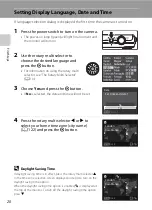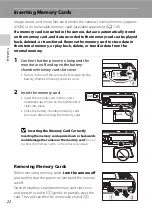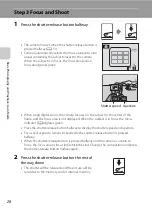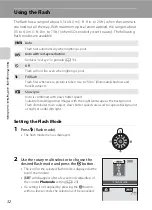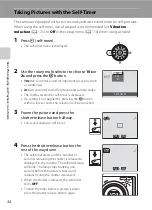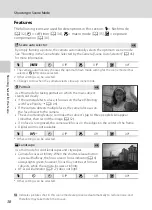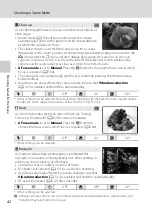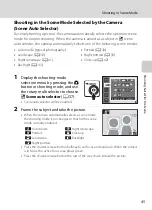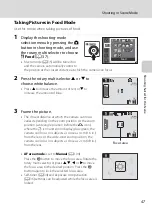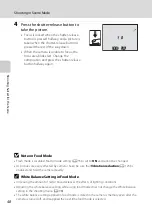
33
Using the Flash
Bas
ic Ph
otography an
d Pl
ayba
ck
: A
uto
Mod
e
B
Shooting When Lighting is Poor and When the Flash is Disabled (
W
)
•
Use of a tripod is recommended to stabilize the camera during shooting and avoid the effects of
camera shake. Set
Vibration reduction
116) to
Off
when using
a tripod to stabilize the camera during shooting.
•
The
E
indicator is displayed when the camera automatically increases sensitivity. Pictures taken
when
E
is displayed may be slightly mottled.
•
When
E
is displayed and higher sensitivity is applied, noise reduction may be automatically
applied as pictures are recorded. This will result in increased recording times.
B
Note on Using the Flash
Reflections from dust particles in the air may appear as bright spots in pictures. To reduce these
reflections, set the flash to
W
(off).
C
The Flash Lamp
The flash lamp indicates the flash status when the
shutter-release button is pressed halfway down.
•
On
: Flash will fire when picture is shot.
•
Blinks : Flash is charging. Wait a few seconds and try again.
•
Off
: Flash will not fire when picture is shot.
If the battery is low, the monitor display will turn off, and
remain off, until the flash is fully charged.
C
Flash Setting
The default flash mode setting varies with shooting mode.
•
A
(auto):
U
auto.
•
Scene mode: setting varies for different scene modes (
•
F
(smart portrait) mode: set to
W
off (when Blink Proof is on),
U
auto (when Blink Proof is off) (
•
Flash cannot be used simultaneously with certain features (
109).
•
s
(subject tracking):
W
off
The flash mode setting applied in
A
(auto) mode is stored in the camera’s memory even after the
camera is turned off, and reapplied the next time
A
(auto) mode is selected.
C
Red-eye Reduction
This camera uses
Advanced Red-eye Reduction (“In-Camera Red-Eye Fix”)
.
Pre-flashes are fired repeatedly at low intensity before the main flash, reducing the red-eye effect.
If the camera detects “red-eye” when a picture is taken, Nikon’s own In-Camera Red-Eye Fix
processes the image before it is recorded.
Note the following when taking pictures:
•
Because pre-flashes are fired, there is a slight lag between when the shutter-release button is
pressed and when the picture is shot. This mode is not recommended when a quick shutter
response is required.
•
The time required to save the picture increases slightly.
•
Advanced red-eye reduction may not produce the desired results in some situations.
•
In extremely rare instances, areas not subject to red-eye may be affected by advanced red-eye
reduction processing; in these cases, choose another mode and try again.


